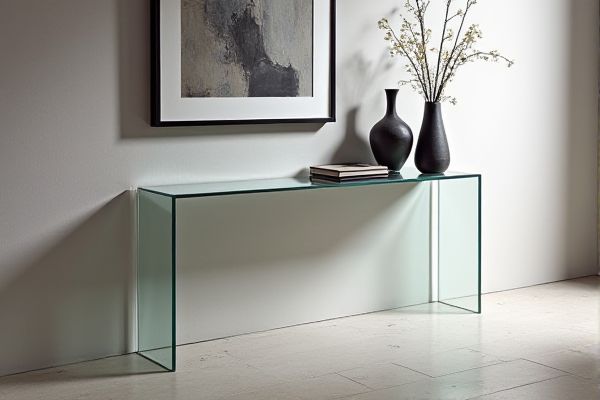
Acrylic consoles offer lightweight durability and shatter resistance, ideal for high-traffic areas, while glass consoles provide a classic, elegant look with greater scratch susceptibility and heavier weight. Explore the detailed comparison to determine which console best suits Your home's style and functionality needs.
Table of Comparison
| Feature | Acrylic Console | Glass Console |
|---|---|---|
| Material | High-quality acrylic plastic | Tempered or regular glass |
| Durability | Impact-resistant, less prone to shattering | Fragile, prone to cracks and chips |
| Weight | Lightweight and easy to move | Heavier, less portable |
| Clarity | Clear but may yellow over time | Crystal clear and maintains clarity |
| Maintenance | Easy to clean, prone to scratches | Smudge and fingerprint prone, easy to clean |
| Price | Affordable to mid-range | Mid-range to premium pricing |
| Design Style | Modern, sleek, versatile | Elegant, sophisticated, luxurious |
| Safety | Shatter-resistant, safer around kids | Breakable, safety glass option available |
Introduction to Acrylic and Glass Consoles
Acrylic consoles offer lightweight durability and shatter-resistant properties, making them ideal for high-traffic areas and homes with children. Glass consoles provide a sleek, polished look with high transparency and scratch resistance, enhancing modern interior aesthetics. Both materials support versatile design options, but acrylic stands out for impact resistance while glass excels in elegance and clarity.
Material Composition: Acrylic vs Glass
Acrylic consoles are made from polymethyl methacrylate (PMMA), a lightweight, shatter-resistant plastic that offers high clarity and flexibility in design. Glass consoles consist of tempered or laminated glass, providing superior scratch resistance and a more luxurious, weighty feel but with increased fragility compared to acrylic. The choice between acrylic and glass consoles hinges on balancing durability, maintenance, and aesthetic preferences linked to their distinct material compositions.
Aesthetic Appeal and Design Versatility
Acrylic consoles offer a modern, minimalist aesthetic with crystal-clear transparency that seamlessly blends into any room, enhancing light flow and creating an illusion of spaciousness. Glass consoles provide a sleek, polished look with varied finishes such as frosted, tinted, or tempered options, adding a touch of elegance and sophistication to interior design. Both materials support versatile designs, but acrylic's lightweight and shatter-resistant properties allow for more innovative shapes and customizable colors compared to the rigid and heavier glass consoles.
Durability and Strength Comparison
Acrylic consoles offer superior impact resistance and are more shatterproof compared to glass consoles, making them ideal for high-traffic areas or households with children. Glass consoles, while elegant and providing a sleek, polished look, tend to be more fragile and prone to cracking or chipping under heavy use. Your choice between acrylic and glass should consider the durability needs of your space and how much wear and tear the console will endure daily.
Weight and Mobility Considerations
Acrylic consoles are significantly lighter than glass consoles, making them easier to move and reposition in your space. The lightweight nature of acrylic reduces the risk of injury or damage during mobility, ideal for frequently rearranged rooms. Glass consoles, while sturdy, tend to be heavier and require more effort and care when being relocated.
Maintenance and Cleaning Requirements
Acrylic consoles require regular dusting with a soft cloth and mild soap solution to prevent scratches and maintain clarity, while avoiding abrasive cleaners that can cause damage. Glass consoles are easier to clean, as they can be wiped with standard glass cleaners for a streak-free finish but are more prone to fingerprints and smudges. Both materials benefit from routine maintenance to preserve their appearance, though acrylic demands more careful handling to avoid surface damage.
Safety Features: Shatterproof vs Fragile
Acrylic consoles offer superior safety features due to their shatterproof nature, making them highly resistant to cracks and breakage compared to glass consoles, which are more fragile and prone to shattering upon impact. Your choice of console affects not only durability but also peace of mind in environments where safety is a priority, such as homes with children or high-traffic areas. Selecting an acrylic console enhances both longevity and security without compromising on style.
Price and Budget Analysis
Acrylic consoles generally offer a more budget-friendly option compared to glass consoles, making them ideal for cost-conscious buyers seeking stylish furniture. Glass consoles tend to be pricier due to the material's fragility, thickness, and manufacturing process, reflecting higher production and shipping costs. Your choice between acrylic and glass consoles will depend largely on your budget constraints and desired aesthetic appeal, as acrylic provides an affordable, durable alternative without sacrificing modern design.
Best Uses and Room Placement
Acrylic consoles are ideal for small spaces and modern interiors due to their lightweight, transparent design that creates an airy feel, making them perfect for entryways, living rooms, or home offices where space optimization is key. Glass consoles, offering a more elegant and reflective surface, suit formal dining rooms, luxurious living rooms, or minimalist bedrooms, enhancing light flow and complementing sophisticated decor styles. Acrylic consoles withstand impact better and are safer in homes with children, while glass consoles require careful placement to avoid heavy traffic areas and potential breakage.
Conclusion: Choosing the Right Console for Your Space
Acrylic consoles offer lightweight durability and a modern, transparent aesthetic ideal for smaller spaces or minimalist designs, while glass consoles provide a sleek, elegant look with increased surface hardness and scratch resistance. Your choice hinges on the desired durability, maintenance, and visual impact, with acrylic suited to casual settings and glass fitting more formal or high-traffic areas. Assessing your space's functional needs and style preferences ensures you select the console that complements your interior perfectly.
 homyna.com
homyna.com